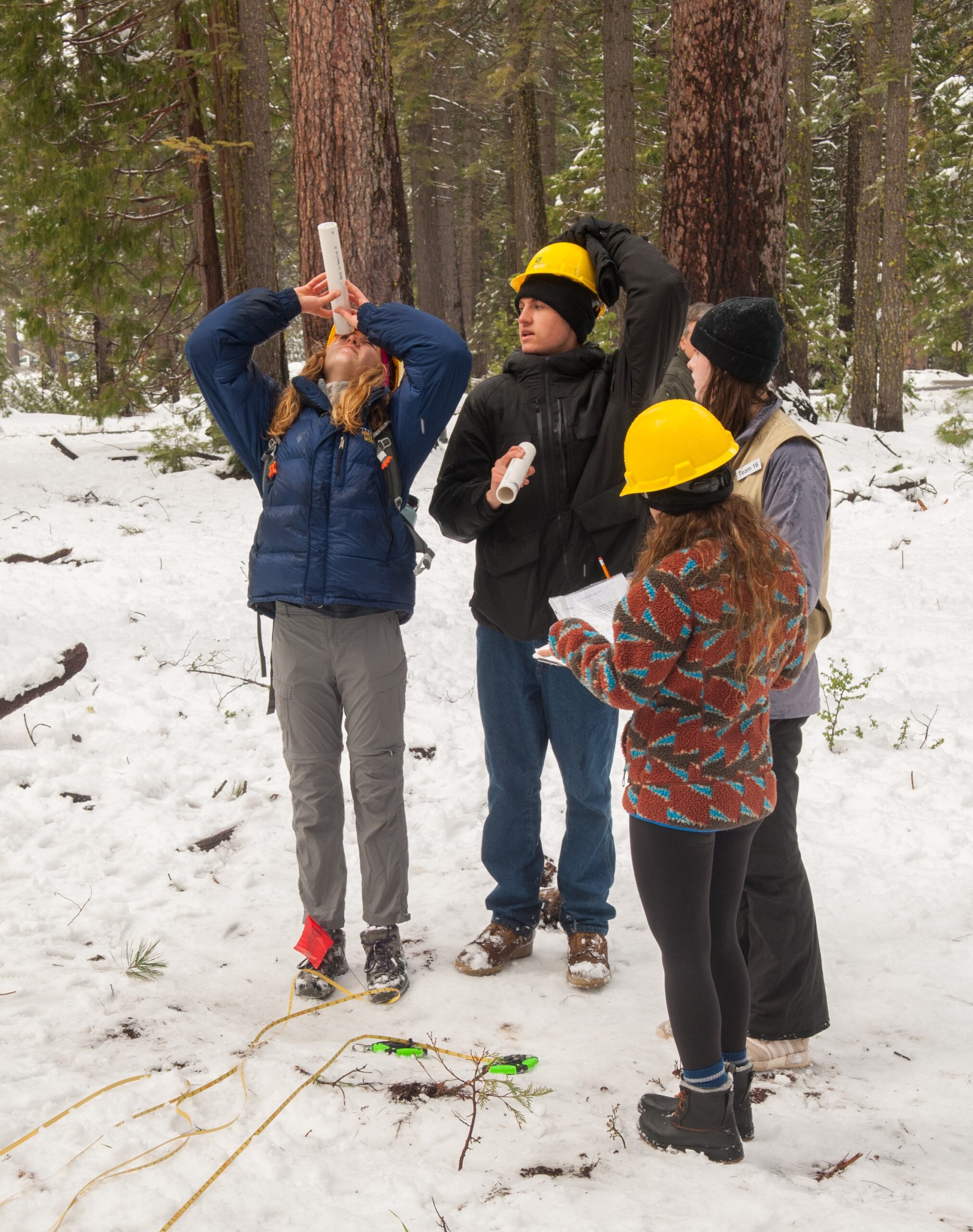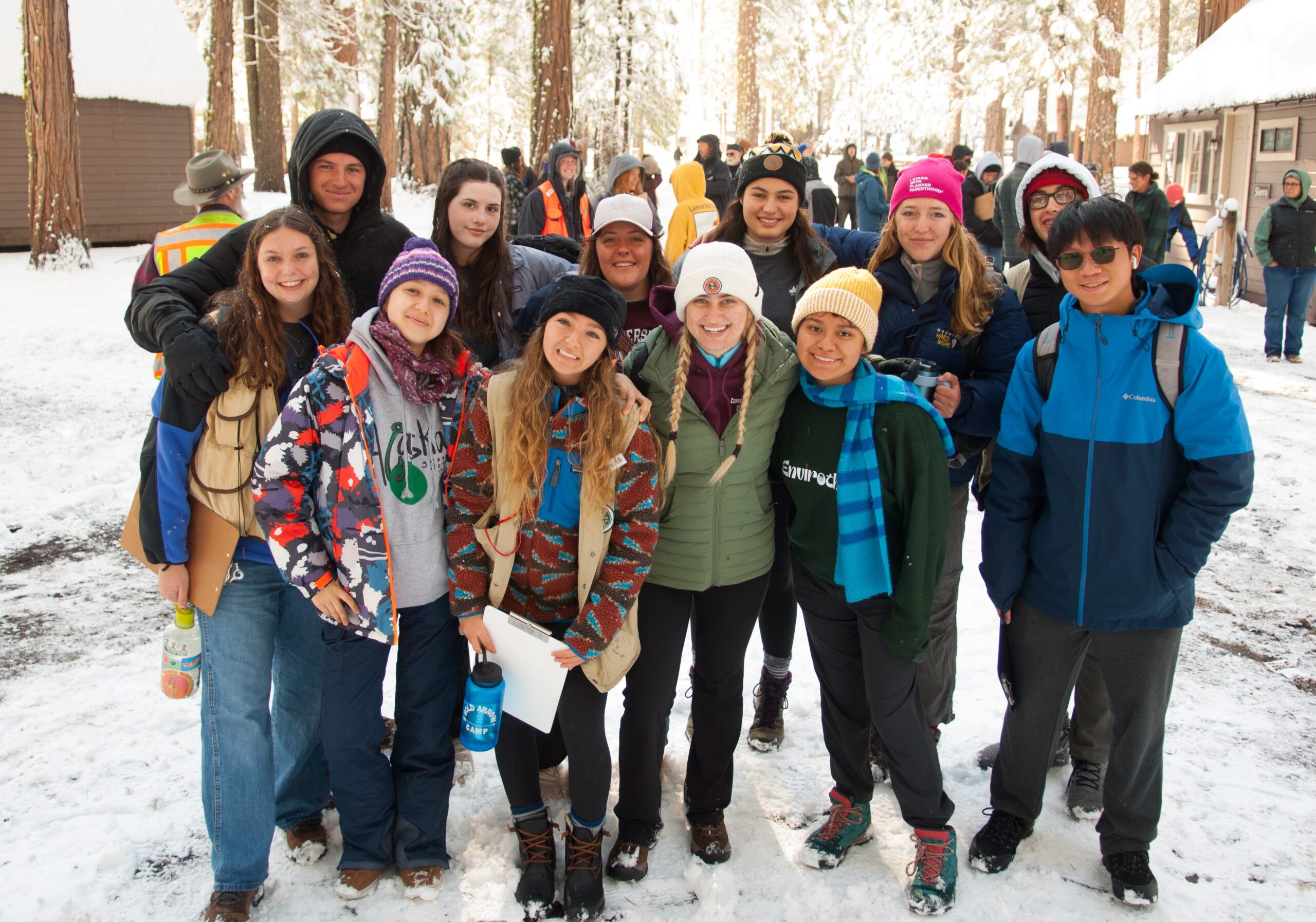
Palisades High School students measured the forest canopy and discussed crown density.
By LAUREL BUSBY
Special to Circling the News
This spring, 12 Palisades High students took a deep dive into climate change and the state’s wildfire crisis at the Forestry Challenge Championship in northern California’s Tuolumne County.
With input from lumber mill representatives, Cal Fire (the state’s Department of Forestry and Fire Protection), and the U.S. Forestry Service, the students gained a broad array of perspectives as they tackled the competition’s challenges, which included data collection and speaking with stakeholders about forestry and wildfires.
“When you throw in climate change and the drought and the fires we’ve been having lately, it kind of makes it a really big deal,” said PaliHi teacher Steve Engelmann, who oversaw the students’ competition efforts over the school year. “A big focus was talking to various stakeholders. A lumber company sees things differently from someone there for recreation who sees the issues differently from a homeowner.”
In April, the students toured a lumber mill, where they viewed “gigantic logs being flipped around,” Engelmann said. They heard about the science behind wildfires. They visited a recent burn site. They were able to query representatives from state and federal agencies as well as people who make their living cutting down trees.
The stamp of climate change pervaded the issues, Engelmann said. For example, both heightened winds and drought conditions stem from climate change and drive the intense fires that have devastated the state’s forests. In addition, the dry conditions have stressed trees, making them more susceptible to bark beetles, a natural enemy that they can normally fend off, but which have killed a vast number of trees in recent years.
In addition, Engelmann noted, more than 100 years of fire suppression has created forests that are prone to fire and so crowded that it’s easier for bark beetles to spread.
“We have unnatural forests from years of suppressing every single fire,” he said. “Climate change is making it a lot more difficult for trees to fight off their natural predators, which have been here forever.” He added that the increase in vacation homes means that at times “when the Forest Service might prefer to let a fire burn, where it might be good for the forest to let the forest burn, they have to jump in there and save structures. Their job is to protect lives and property.”
The students considered controlled burns, which have been one way to address the crowding of the forests, Engelmann said. These burns aren’t intended to burn trees as much as reduce the fuel so that unplanned fires don’t reach the crown layer of the trees. In addition, forests might be thinned by seeking out trees infested by bark beetles, while leaving healthy trees.
Maintaining healthy forests, which requires different actions based on the type of trees involved, such as pine versus oak, was another issue to consider, he noted. Trees help fight climate change not only by removing carbon dioxide from the air, but also by pulling water from the ground and releasing it into the air, which is one cause of precipitation.
“When the forest is gone, the climate changes,” Engelmann said.
To help the students learn more about the issues, the U.S. Forestry Service “gave the students a behind-the-scenes view of the complicated issues of managing California’s forests. Some people think they’re cutting down too many trees. Some people think they’re not cutting down enough. They’re trying to find that right balance based on science. There are interest groups on all sides. It’s a complicated issue and a struggle to resolve.”
Three teams of four students each had earned an invitation to the event through their high scores at a regional competition in San Bernardino County, won by the PaliHi team of Samuel Javidanfar, Andrew Wu, Andrea Arreortua and Diana Ovod (which finished fifth at the state championship). The team of Maya Millner, Stella Becir, Jenna Barad and Livia Rosenmayr came in fifth in San Bernardino but earned second place at Pinecrest with a score of 197.7 points versus Foresthill High School’s 199.3 total. The third Pali team (Ella Taghibagi, Cleo Waxman-Lee, Maren Carere and James Lewis) placed ninth in the finals.

PaliHi team participated in the Forestry Challenge Championship in Tuolumne County. Some students experienced snow for the first time.
A key benefit of the Tuolumne County event was the chance for the students to interact with people who hold opposing viewpoints to theirs, Engelmann said. For example, some of the students spent time discussing environmental issues with a man who they perceived with shock to be a climate change denier.
The next day Engelmann chatted with this man, and the fellow told him, “I really liked hanging out with the kids. Sometimes we old folks, we get stuck in our ways. Maybe we need to change a bit.”
While the people who deal with resource extraction, whether loggers, fishermen or ranchers, tend to be more conservative, Engelmann said, “when you meet them in person, these are nice people. I can have a conversation with them…. We need to have these conversations. They’re not crazy. We’re not crazy. We just need to talk.”

PaliHi science teacher Steve Engelmann (left) speaks with a Forestry Service provider at the camp.

This is amazing!!
Sounds like a great opportunity for the students. Thanks for reporting on this.
Congratulations Pali High students for making sure the people in charge know you’re watching their decisions, and for having tough conversations with people from all walks of life!
And thank you Laurel for sharing this important advocacy with the community.
This was an amazing opportunity that myself and my peers were able to have through Pali High’s Envirothon club. It was very interesting to speak with forestry professionals to learn about their stance on the climate crisis. Like the article mentioned, the forestry professionals were interested in what we had to say and hopefully the conversations we had with them were eye-opening. Thank you to Circling the News for continuing to write articles about the climate crisis!
Thank you for Laurel Busby’s article. The work of Steve Engelmann and his students is inspiring!
As a former science teacher, I am thrilled to know that PaliHi students have the opportunity to compete in competition challenges that engage them in understanding climate change and environmental issues related to the state’s wildfire crisis. The ability to enhance their skills in data collection and analysis as well as speaking to stakeholders is such an important example of how to engage this generation of students in authentic problem solving and application of scientific method. The opportunities to see first-hand the impact of climate change and learn from representatives of Cal Fire and the U.S. Forestry Service are extraordinary.
My favorite part of the piece had to do with the chance for students to interact with people who old opposing viewpoints including the man who they perceived to be a “climate change” denier. The outcome whereby he shared with Mr. Engelmann that showed his willingness to consider the “need to change a bit” is an example for all of us in trying to overcome some of the vitriol and inability to enact coherent policies without the intransigence, based upon political ideology, and failure to have rational dialogue.
Since serving as PaliHi principal, I have engaged in research about how to improve instructional practices pre-K to 12th grade. Both at CSUN and UCLA, I have served as an instructor for future educational leaders on how to connect to students who are immersed in technology, social media, and a variety of factors that make their experiences at home and in school different from my own generation of the 50’s and 60’s.
My own experience and findings in relation to the challenges of educating in these times, have landed on the principles of socio-cultural learning theory, culturally responsive pedagogy, and constructivist pedagogy. All of this means helping teachers find ways of authentically engaging students in activities and problem-solving that are relevant and important to the world they live in. It is a way of building on students’ s prior knowledge, and experiences at home and in their communities, rather than “teaching to a standardized test” or rote memorizing of disconnected facts. Teachers need to find way to help students use the tools of technology to explore their world and make meaning of their own lives and futures. I can think of no better example than the work of Steve Engelmann with his students at Pali and how they are learning about how to solve real world problems. I also know there are many others at Pali, including the Human Rights educators, who are providing students with learning opportunities to understand the world they live in, but more importantly, how they make it a better world for them to live in and for future generations.
Please keep up the great work at Circling the News by covering these educators and their students.